© Borgis - New Medicine 4/2014, s. 146-150
*Ibolya Krèmer Lipiennè1, Mihály Dió2, Judit Mèszáros3
Burn-out Research Among Midwives
1Department of Clinical Studies in Obstetrics and Gynaecology, Faculty of Health Sciences, Semmelweis University, Budapest, Hungary
Head of Department: prof. János Rigó, PhD
2Department of Medical Imaging and Technology, Faculty of Health Sciences, Semmelweis University, Budapest, Hungary
Head of Department: Attila Doros, PhD
3Faculty of Health Sciences, Semmelweis University, Budapest, Hungary
Head of Faculty: prof. Zoltán Zsolt Nagy, PhD
Summary
Inroduction. The stress in work takes a prominent part in the developing of the burn-out, that is why in this research we wondered if we can find this symptom in the maternities which is the most beautiful part of the public health.
Aim. During our research we were seeking for the answer if the Burn-out-syndrome incidence can be found, and if so, to what extent among the midwives working in the Hungarian Health Institutions. In addition, we were also curious what connections there are between the burn-out and the socio-demographic factors.
Material and methods. For our research we used the Maslach Burnout Inventory (NBI) questionaire compiled by Maslach and Jackson.
Results. This questionaire consists of 22 theorems which can be completed easily and can be written up well. The questionaire was compiled especially for the examination of the burn-out people working in the human service sector. During the filling in of the questionaire we paid great attention to the equal division between the maternities, both in Budapest and in the provincial hospitals. Finally, 500 questionaires were given out: 283 came back from which 223 were adequate for being written up.
The questionaires were given out and collected by head midwives or for personal request. According to the results of the research we can claim that the midwives’ stress burdening is likely special and is utterly different from each specialist’s working in different fields of the Health Care.
Conclusions. In our questionaires we did not find a decided difference between the midwives’ socio-demographic factors and the developing of the burn-out.
Introduction
These days more and more national and international essays prove the connections between the burnt-out people working in Health Care and the symptoms developed as a result of the burn-out on phisical-spiritual and mental level. In the scientific literature the notion of the burn-out was mentioned first in 1974 which was used by the psychoanalitic Herbert Freudenberger for the description of the professional behaviour (1).
The most popular experts of the Burn-out syndrome are Maslach and Jackson, who describe it as a multi-dimensional symptom. The questionaire compiled by them the Maslach Burnout Inventory, measures through three dimensions. The first dimension is the emotional burn-out which may be the most important problem regarding to the shortage of the person’s emotional sources. The second dimension is the depersonalization which regards to the forming of the negative and depersonalized attitude with the client/patient, as well as, people with whom they work. While the third dimension regards to the personal efficiency and the decrease of the personal performance which suggests that the person’s performance widely differs from which he or she can expect himself or herself, to which high-grade negatíve self-estimation may associate (2, 3).
The working atmosphere, the monotonious tasks, the antipathy felt against some patients, the private problems came from the financial difficulties and the lack of time, as well as, the phisical syndroms occur as striking factors (4).
Facing to the problem, the social join in refering to the difficulty still fail to happen considerably. However, there are some attempts, courses but they are still not enough since exactly those people are unable to take part who are greatly involved. Nevertheless, one can always lend a hand during their work (which is extremely essential in Health Care) only if there are some opportunities where they are able to „recharge” themsleves.
These days, however, the institutions in Health Care are trying to survive the financial recession and are attempting to find the solutions for their financial problems, whereas, they do not aim at giving a helping hand to their workers to improve both their physical and pshyological states. These workers are overburdened, they have to face with stress since they are under constant pressure day by day: their work and their private lives often merge which results a great number of problems and it is an important hotbed of the psyhological weariness and burn-out. The fact of overburden, the exit of the patients and the fact that their work has not at last been recognized all lead to their burn-out (5).
In addition, the personal intelligency with work experience, the environment at work, and their own lifestyle extremely influence the burn-out.
For many centuries, the childbirth was a family event since it happened in familiar atmosphere. This is why the helping at labours is the same age as the humanity and it was done, for a long time, by exclusively those women who had already born or in better cases by midwives who were able to impart their acquired experience and skill to the younger generations (6).
During our practice at work, We have experienced several times that the midwives’ job is a very compound procedure since in the labour-room the observation of the mother’s and baby’s signs of life, the following of the progress of the labour needs constant attention, the ability of decision making, as well as, great skill, nevertheless it involves great dangers, too. Working in Health Care requires perfect accomplishment since the society tend to make a judgement at once. It is impossible to make a mistake or make a false decision. Among the Health Care workers it is the midwives that prove the proper control, caring and guidance for pregnant women during the pregnancy and the labour, as well as, in the post-partum period. They are capable to assist at birth individually and to care the newborn babies. All women in labour are due to respect, correct information, guidance and the patient answers for their questions. The way how a woman labours extremly depends on the quality of the circumstances, and the helpers. This is why the role of midwives is so important.
Aim
The purpose of the present research is to make a survey, to learn to what extent the burn-out occurs among the midwives working in the Hungarian Health Institutions. Additionally, we would like to reveal the connections of the burn-out with the sociodemographic factors. We would also like to examine those stress effects which come from the responsibility of the midwives, that is, how much burden is imposed on them in the current situation of the Health Care. We were also curious about the connections between the intensity and the frequency of depersonalisation, as well as, the age of the midwives answering to our questionaires.
Material and methods
The midwives taking part in the research formed their opinions about the extent of their stress burden at work, their burn-out, as well as, the presence of the depressive symptoms. During the survey we paid great attention to divide the questionaires in equal proportion among the midwives working in the Health Care in Budapest or in the country.
Many researchers have dealt with the burn-out, but the most popular questionaire of all is the Maslach Burnout Inventory (MBI) which was compiled by Maslach and Jackson. The questionaire includes 22 thesis, which can be completed and written up easily. The questionaire was compiled especially for the examination of the people working in the human servive sector (2,7).
The writing-up of the theses is done on a seven-scored scales and measures along three important dimensions: the emotional exhaustion, the depersonalization from colleagues and patients/clients and the decrease of the personal effect. The use the questionaire is spread throughout the world which should be used in such research in which we would like to reflect to the dependence of an effect upon a cause. The number of the articles which are about burn-out has greatly increased in our country, too. Similar research has been done in great number of fields in Health Care, so doctors, female and male nurses were mainly examined but also medical students helped with their answers. It is extremely difficult to find dependences among the Hungarian research, since the researchers examined the burn-out from several aspects, for example, from the aspect of the person, as well as, from the point of the Health Care. Thus, Szicsek, Hegedűs and their co-workers’ work is likely significant, who had mainly examined the role of the atmosphere of work and the „partners’ care-net”. Pikó had stressed the dependences between the role conflicts and the psichosomatic matters, but Pálfi had put the stress mainly on the ward which provides the medical treatment. His research also proves that burn-out among the intensive-care workers (10.7%) is twice as high as among the workers in the wards (3.6%) (8).
In case of nurses working in chronical wards/gerontology the burn-out also has determinants since the patients’ problems can be emotionally burdening for the caring nurses. It is proved by Hegedűs et al. research (9).
Results
According to the statistical writing-up of the given back MBI questionaires, we did not use data-correcting technics, but we had written up only those questionaires which were filled in properly. The incorrect questionaires were ruled out. As a result of this, from the 283 questionaires finally 223 were written up. It counts a fairly considerable quantity comparing the number of the midwives working in our country. The MBI questionaire was made with the "valid" method, so we can disregard its extra validitation. There was a recommended analyzing scheme avaible for writing up the questionaire which specified the classification of the results of the question groups co-ordiaeted according to different dimensions, as well. Thus, the questionaire settles the low, the middle and the high level zone values belonging to the parameter. With its help, we can summarize the results in table 1. The number of the answerers belonging to the level is in terms of percentage to the number of the all answerers.
Table 1. The division and level of the MBI dimensions.
| MBI dimensions | Persons on MBI levels (%) |
| Low | Middle | High |
| The Frequency of Depersonalization | 45 | 32 | 23 |
| The Intensity of Depersonalization | 40 | 39 | 21 |
| The Frequency of Personal Effect | 48 | 26 | 33 |
| The Intensity of Personal Effect | 24 | 31 | 45 |
| The Frequency of the Emotional Exhaustion | 24 | 40 | 36 |
| The Intensity of the Emotional Exhaustion | 35 | 45 | 20 |
The relation of the dimensions to other factors could also be interesting. Thus, just to mention a few facts, the correlation with the age, with the number of the years spending in the Health Care, with the peculiarities of the work, with the qualification and with the working field completed could be examined. Also, our survey makes the examination of these facts possible. In this case, it shows the relation of the age, as well as, the relation to the MBI factors. As a matter of clearness, we use a scatter plot diagram of which horizontal ordinate/axis shows the age, and the vertical ordinate/axis shows the MBI scores (fig. 1-6).
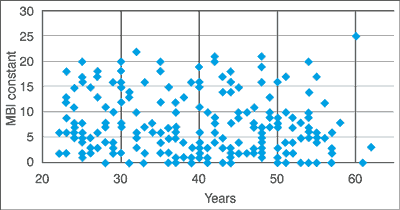
Fig. 1. The Frequency of Depersonalisation (r = -0.086; p = 0.202). The MBI constant occurs on the vertical axis and the years of the human life occurs on the horizontal axis.
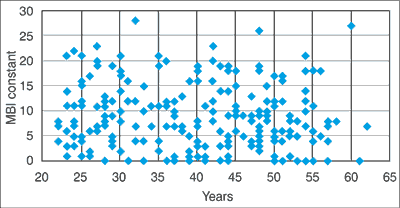
Fig. 2. The Intensity of Depersonalisation (r = -0.064; p = 0.344). The MBI constant occurs on the vertical axis and the years of the human life occurs on the horizontal axis.
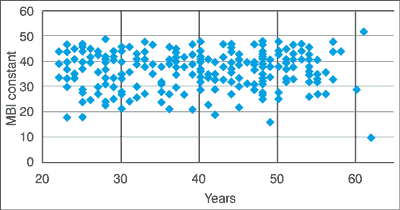
Fig. 3. The Frequency of Personal Potency (r = -0.058; p = 0.387). The MBI constant occurs on the vertical axis and the years of the human life occurs on the horizontal axis.
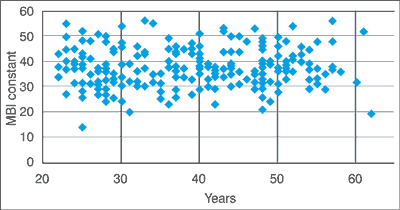
Fig. 4. The Intensity of Personal Potency (r = -0.046; p = 0.494). The MBI constant occurs on the vertical axis and the years of the human life occurs on the horizontal axis.
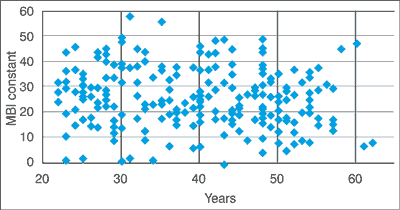
Fig. 5. The Frequency of Emotional Burn-out (r = -0.107; p = 0.110). The MBI constant occurs on the vertical axis and the years of the human life occurs on the horizontal axis.

Fig. 6. The Intensity of Emotional Burn-out (r = -0.044). The MBI constant occurs on the vertical axis and the years of the human life occurs on the horizontal axis.
Besides the vizualization, and with the help of the SPSS project, we have also subjected the data to statistical analysis. The parameters of the standard correlation and the significant levels were registered in this way. According to the method used by us, it is only worth considering the relations to be appreciable if the value of the Pearson’s correlation – factor is higher than 0.7. We can consider it characteristic to the population if the value of the significancy is lesser than 0.05.
Although the constants are incorrelative, it does not mean that there is not a close correlation between the two sets of constants. It is possible that the years of the human life affects in a very complicated way or with other parametres. Further analyses are needed. On the other hand, the huge dissemination also means that the majority of the midwives did not casually fill in the questionaires, since in this case, the validated questionaires would have changed the resultss towards the middle direction. But in the case of the given dimension, the consistent answers have changed the given answers of the midwives to one direction. In many cases it resulted dissemination.
Conclusions
The aim of our research was to examine if the Burn-out syndrom is present among those midwives who work at maternities in Hungary. These given facts were brought into connection with the socio-demographic factors. In our research we tried to find some conections and draw a parallel betwen the NBI factors and the age of the midwives. In the research, as we have alredy mentioned before, we initiated the midwives both from Budapest and the country. Compering the Burn-out factors, it seems that in the Hungarian Health Care there is a small field where the Burn-out syndrome cannot be proved.
We assume that the explanation of this fact is because these midwives work in rotary system in the maternities, that is, they work in different areas within the maternity department every one or two years, for example, puerperal ward, labour ward, antenatal ward, ginecology ward.
On the other hand the midwives’ work is greatly influenced by the presence and help of the doctors, and therefore, they do their work with lesser responsibility and competence. Firstly, we assume especially those midwives’ work who work in the delivery rooms, and who contrary with their competence, are not allowed to close a wound by sutura alone, and to conduct the delivery individually. Althaugh, it is completely determined in the 14/2000 (V.12) Ministry of Health order which must be the midwives’ individual and non-individual competencies, they are not allowed to act alone without the presense of a doctor. In order to be adaptable to the EU’s requirements, the midwives’ training in Hungary is adjusted to the EU’s standards. However, the tasks done by the midwives do not succeded the practice in reality. Concerning the data of age, we have not found any extreme differencies in the regularity and strength of alientation.
Further research aims
Our research may occur a base for further similar research. We would also wish to examine whether there is a correspondence between qualification, the location of the home and the Burn-out syndrom. The given results will be compared with international research.
Piśmiennictwo
1. Fekete S: Segítő foglalkozások kockázatai. Helfer szindóma ès burnout jelensèg. Psychiatria Hungarica 1991; 1: 17-29. 2. Kovács M: A kiègès jelensège a kutatási eredmènyek tükrèben. LAM 2006; 16(11): 981-987. 3. Maslach C, Jackson SE: Burnout in health professions. A socialpsychological analysis. [In:] Sanders GS, Suls J (eds.): Social Psychology of Health and Illness. NJ Erlbaum, Hillsdale 1982: 227-247. 4. Győrffy Zs, Ádám Ss: Az egèszsègi állapot, a munkastressz ès a kiègès alakulása az orvosi hivatásban. Szociológiai szemle 2004; 3. 5. Pálfi F: A kiègès jelensègènek vizsgálata ápolók körèben. Egèszsègügyi Menedzsment, 2002. 6. Buda J: Az anyaság ès bábaság törtènete Pècsi Orvostudományi Egyetem Egèszsègügyi Főiskolai Kar. Pècs 1996. 7. Maslach C, Jackson SE: Maslach Burnout Inventory: Manual (2nd). Palo Alto, CA Consulting Psychologists Press 1993. 8. Pálfinè Szabó I: Ápolói ès gondozói magatartások alakulása különböző ellátási helyzetekben, különös tekintettel a kiègès jelensègère 2008. ORVOSI HETILAP. 9. Hegedűs K, Riskó Á, Mèszáros E: A súlyos betegekkel foglalkozó egèszsègügyi dolgozók testi ès lelki állapota. LAM 2004; 14: 786-793.





